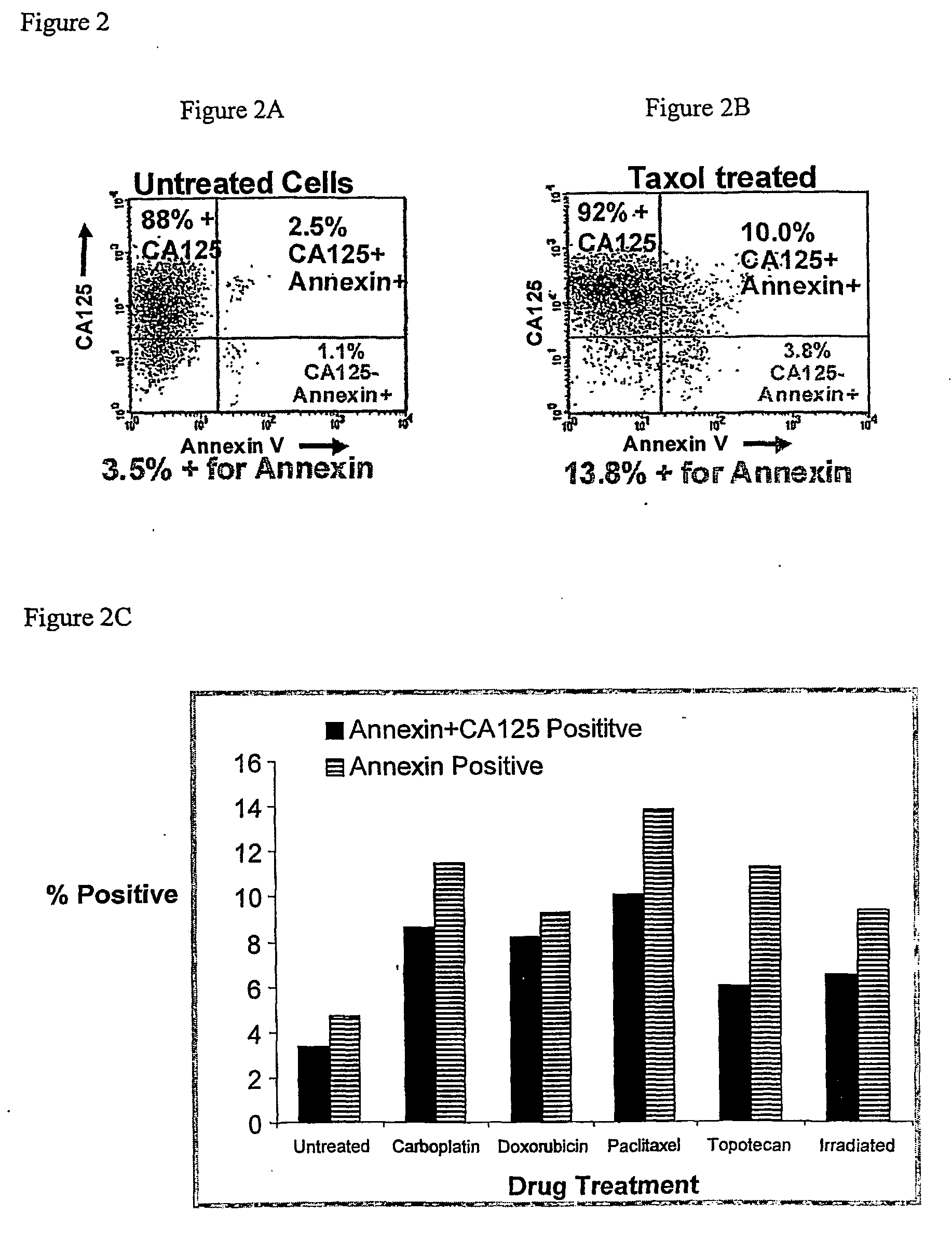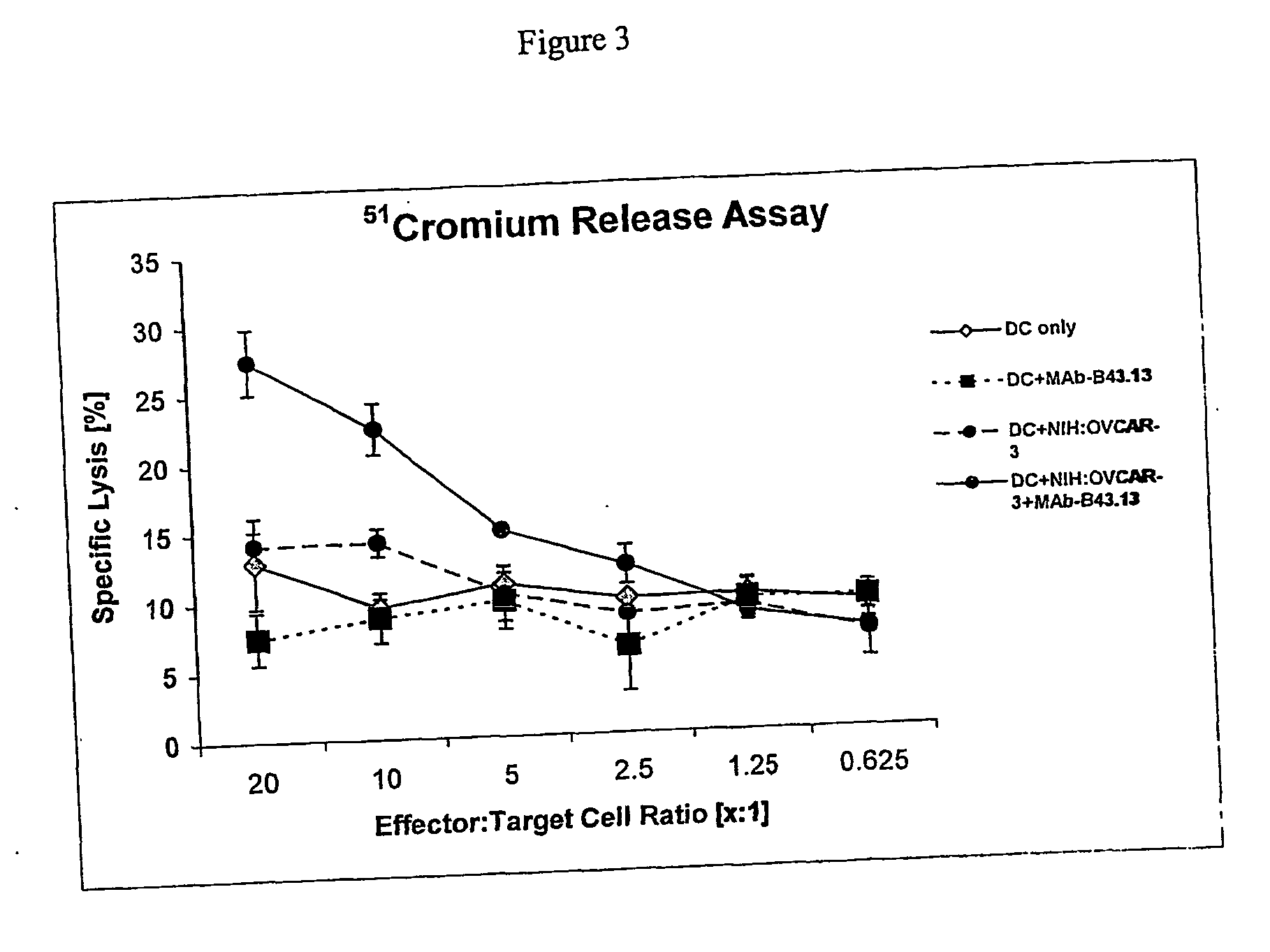Binding agents and their use in targeting tumor cells
a technology of binding agents and tumor cells, applied in the field of immunology, can solve the problems of reducing or negating the effectiveness of many chemotherapeutic agents, chemotherapy is not specific to tumor cells, and destroys other proliferating cells such as blood cells, so as to reduce the number of target cells in the patient, reduce the proliferation of and/or kill target cells, and induce endocytosis of apoptotic target cells
- Summary
- Abstract
- Description
- Claims
- Application Information
AI Technical Summary
Benefits of technology
Problems solved by technology
Method used
Image
Examples
example ii
[0174] Twenty human patients diagnosed with recurrent ovarian cancer entered a study of non-radiolabeled murine MAb-B43.13 in combination with standard chemotherapeutic agents. Patients received twenty minute infusions of 2 mg of MAb-B43.13 at weeks 1, 3, 5, and 9, and a further optional dose at week 12. After treatment with MAb-B43.13, patients received standard chemotherapy and an optional dose between weeks 12 and 26. Disease progression was assessed using CT scans, physical exam, CA125 levels, and long-term follow-up for survival. T cell responses to autologous tumor were assessed in eight patients using ELISPOT Assay.
T Cell Responses
[0175] Patients peripheral blood mononuclear cells (PBMC) were thawed using standard techniques. The PBMC were allowed to sit for 2 minutes in the DNAse thaw media before washing. PBMC were washed once by first adding 8 mL AIM V media (commercially available from Gibco / Invitrogen Corporation, Carlsbad, Calif.). PBMC were resuspend in 10 mL AIM V ...
example iii
[0185] Assays were preformed as described for Example I with the following modifications. NIH:OVCAR-3 tumor cells were purchased from ATCC, Manassas, Va. The murine monoclonal anti-CA125 antibody B43.13 (AltaRex Corporation, Edmonton, Alberta, Canada) was produced in mouse ascites and purified by Protein A affinity and anion exchange chromatography. This IgG1 antibody reacts specifically and with high affinity with CA125. NIH:OVCAR-3 tumor cells were rendered apoptotic by treatment with Taxol (1 μg / mL) or doxorubicin (100 μg / mL) for 24 h. Cells were washed and removed from culture dishes by trypsin digestion, centrifuged and resuspended in cRPMI. A portion of the cells was incubated with 5 μg / ml of MAb-B43.13 for 30 minutes on ice and washed again, whereas the remaining cells were incubated on ice for 30 minutes without addition of antibody. NIH:OVCAR-3 cells were also rendered necrotic by submitting them to 3 cycles of freeze-thaw. MAb-B43.13 antibody (5 μ / mL), apoptotic and necrot...
example iv
[0189] Assays were performed as described for Example 1 with the following modifications. NIH:OVCAR-3 tumor cells were purchased from ATCC, Manassas, Va. The murine monoclonal anti-CA125 antibody B43. 13 (AltaRex Corporation, Edmonton, Alberta, Canada) was produced in mouse ascites and purified by Protein A affinity and anion exchange chromatography. This IgG1 antibody reacts specifically and with high affinity with CA125. NIH:OVCAR-3 tumor cells were rendered apoptotic by treatment with the chemotherapeutics doxorubicin (100 μg / mL, Taxol (1 μg / mL), topotecan (2.5 μg / mL) and carboplatin (100 μg / mL) for 24 h or by irradiation (10,000 rad) as well as made necrotic by repeated freeze-thaw. Cells were washed and removed from culture dishes by trypsin digestion, centrifuged and resuspended in cRPMI. A portion of the cells was incubated with 5 μg / ml of MAb-B43.13 for 30 min. on ice and washed again, whereas the remaining cells were incubated on ice for 30 min. without addition of antibody...
PUM
| Property | Measurement | Unit |
|---|---|---|
| concentrations | aaaaa | aaaaa |
| time | aaaaa | aaaaa |
| total volume | aaaaa | aaaaa |
Abstract
Description
Claims
Application Information
 Login to View More
Login to View More - R&D
- Intellectual Property
- Life Sciences
- Materials
- Tech Scout
- Unparalleled Data Quality
- Higher Quality Content
- 60% Fewer Hallucinations
Browse by: Latest US Patents, China's latest patents, Technical Efficacy Thesaurus, Application Domain, Technology Topic, Popular Technical Reports.
© 2025 PatSnap. All rights reserved.Legal|Privacy policy|Modern Slavery Act Transparency Statement|Sitemap|About US| Contact US: help@patsnap.com



